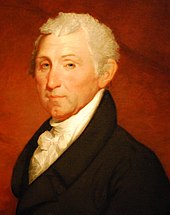Election of 1820
|
|
|||||||||||||||||||||||||||||
|---|---|---|---|---|---|---|---|---|---|---|---|---|---|---|---|---|---|---|---|---|---|---|---|---|---|---|---|---|---|
|
|||||||||||||||||||||||||||||
|
All 229/232 electoral votes of the Electoral College 115/117 electoral votes needed to win |
|||||||||||||||||||||||||||||
|
|||||||||||||||||||||||||||||

Presidential election results map. Green denotes states won by Monroe, light green denotes New Hampshire elector William Plumer's vote for John Quincy Adams. Numbers indicate the number of electoral votes allotted to each state. Missouri's statehood status and subsequent electoral votes disputed.
|
|||||||||||||||||||||||||||||
|
|||||||||||||||||||||||||||||
James Monroe
Democratic-Republican
James Monroe
Democratic-Republican
The United States presidential election of 1820 was the ninth quadrennial presidential election. It was held from Wednesday, November 1, to Wednesday, December 6, 1820.
Taking place at the height of the Era of Good Feelings, it was the third and last United States presidential election in which a candidate ran effectively unopposed (the previous two unopposed presidential elections were those of 1788–89 and 1792, in which George Washington ran without serious opposition). President James Monroe and Vice President Daniel D. Tompkins were re-elected effortlessly and captured all but one electoral vote. The failing Federalist Party did participate in the election of 1820 by fielding a serious vice-presidential candidate (), but was unable to nominate a national candidate for president. It was never able to participate again in any federal election.
Despite the continuation of single party politics (known in this case as the Era of Good Feelings), serious issues emerged during the election in 1820. The nation had endured a widespread depression following the Panic of 1819 and momentous disagreement about the extension of slavery into the territories was taking center stage. Nevertheless, James Monroe faced no opposition party or candidate in his re-election bid, although he did not receive quite all of the electoral votes (see below).
...
Wikipedia

